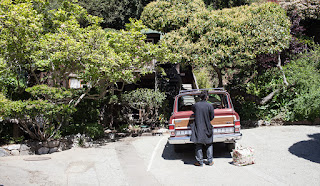From Los Angeles To San Francisco
Road Trip Guide
Vol. 02
For the 'West Coast' feature in Popeye magazine's 40th anniversary issue (July 2016), Hiroki Nakamura and his partner Kelsi set out a 4-day, 3-night road trip from Los Angeles to San Francisco. There were many photos from the trip that weren't used in the new issue, so we decided to use these extra photos with the original story to make a travel guide.
Big Sur
Known for its picturesque views from cliffs shadowing the Pacific coast, Big Sur is an area along 'California State Route 1,' approximately 300 miles north of Los Angeles. Big Sur winds endlessly along the coast from Carmel-By-The-Sea to Hearst Castle, a distance of about 90 miles from north to south. The mystique and spiritual mood set forth by the Sequoia forests, beautiful sandy beaches that seals gather on, and sunsets sinking into a horizon covered by thick fog have long attracted bohemian writers to this place. Starting with novelist Henry Miller who emigrated in 1944, many artists including Jack Kerouac, Richard Brautigan, and Hunter S. Thompson have stayed in the area. Just south of Carmel lies the 'Esalen Institute,' a worldwide training center for bodywork and psychology that has been around since the 1960s, complete with its own hot spring facilities. 'Nepenthe' is one of the locations that Kerouac visited that still exists today, and has since become one of the most famous tourist attractions in the area.
Deetjen's Big Sur Inn
'Deetjen's Big Sur Inn,' one of Nakamura's regular stops in the area, is a guesthouse and restaurant that was managed by an immigrant Norwegian couple who moved here in the 1930s. Built in the middle of a redwood forest, the rustic and elegant accommodations were constructed in a traditional Scandinavian style that contributes to its antiquated atmosphere, and has even been placed on the American National Register Of Historic Places. Also serving as the main building, the restaurant has become a well-known establishment itself, serving up meals crafted with organic local produce and carefully selected California wines that can be enjoyed in a romantic candle lit dining room making it a difficult reservation to secure.
Henry Miller Memorial Library
The Henry Miller Memorial Library was founded out of respect for Henry Miller, a novelist who lived in Big Sur from 1944 to 1962, and published 'Big Sur And The Oranges Of Hieronymus Bosch' in the year 1957. Although labeled a library, the shop is actually a bookstore. The cabin-style shop standing in the middle of a grove is lined with books from writers like Miller, Kerouac, and other authors with an affinity for Big Sur. Visitors are able to relax over free coffee on the deck which overlooks the lawn. Also serving as a venue for live performances by bands in love with the area, including the Red Hot Chili Peppers, as well as film screenings, this place has cemented its status as one of the cultural spots in Big Sur.
Asilomar Conference Grounds
Located within the 'Asilomar State Beach,'a state park in Pacific Grove of the Monterey Peninsula, the 'Asilomar Conference Grounds' is a conference center that was established as a leadership camp for use by the YWCA (Young Women's Christian Association) in 1913. The grandness and beauty of the 'Phoebe Hearst Social Hall' is enhanced by its enormous stone fireplace, which now functions as the administrative building. Other structures on the conference grounds feature a naturalistic architectural approach, heavily influenced by the Arts And Crafts Movement. Built from 1913 - 1928, the buildings were designed by prolific early-20th century architect Julia Morgan, and have also been placed on the American National Register Of Historic Places.
Monterey Speed & Sport
Located in the beautiful ocean-side resort town of Monterey was a place that Nakamura had 'wanted to visit for some time.' That place is a company operated by Mr. Donald Orosco, a former car racer and vintage car expert. The company's main business is restoring classic cars. Mr. Orosco's beautiful car collection lines the inside of the building, where he also stocks a cornucopia of vintage auto parts.
Visvim












































